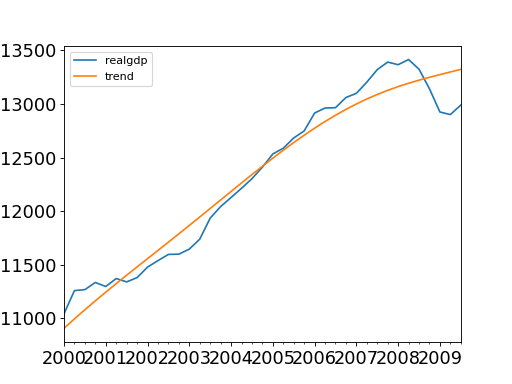statsmodels.tsa.filters.hp_filter.hpfilter¶
-
statsmodels.tsa.filters.hp_filter.hpfilter(x, lamb=
1600)[source]¶ Hodrick-Prescott filter.
- Parameters:¶
- xarray_like
The time series to filter, 1-d.
- lamb
float The Hodrick-Prescott smoothing parameter. A value of 1600 is suggested for quarterly data. Ravn and Uhlig suggest using a value of 6.25 (1600/4**4) for annual data and 129600 (1600*3**4) for monthly data.
- Returns:¶
See also
statsmodels.tsa.filters.bk_filter.bkfilterBaxter-King filter.
statsmodels.tsa.filters.cf_filter.cffilterThe Christiano Fitzgerald asymmetric, random walk filter.
statsmodels.tsa.seasonal.seasonal_decomposeDecompose a time series using moving averages.
statsmodels.tsa.seasonal.STLSeason-Trend decomposition using LOESS.
Notes
The HP filter removes a smooth trend, T, from the data x. by solving
- min sum((x[t] - T[t])**2 + lamb*((T[t+1] - T[t]) - (T[t] - T[t-1]))**2)
T t
Here we implemented the HP filter as a ridge-regression rule using scipy.sparse. In this sense, the solution can be written as
T = inv(I + lamb*K’K)x
where I is a nobs x nobs identity matrix, and K is a (nobs-2) x nobs matrix such that
K[i,j] = 1 if i == j or i == j + 2 K[i,j] = -2 if i == j + 1 K[i,j] = 0 otherwise
See the notebook Time Series Filters for an overview.
References
- Hodrick, R.J, and E. C. Prescott. 1980. “Postwar U.S. Business Cycles: An
Empirical Investigation.” Carnegie Mellon University discussion paper no. 451.
- Ravn, M.O and H. Uhlig. 2002. “Notes On Adjusted the Hodrick-Prescott
Filter for the Frequency of Observations.” The Review of Economics and Statistics, 84(2), 371-80.
Examples
>>> import statsmodels.api as sm >>> import pandas as pd >>> dta = sm.datasets.macrodata.load_pandas().data >>> index = pd.period_range('1959Q1', '2009Q3', freq='Q') >>> dta.set_index(index, inplace=True)>>> cycle, trend = sm.tsa.filters.hpfilter(dta.realgdp, 1600) >>> gdp_decomp = dta[['realgdp']] >>> gdp_decomp["cycle"] = cycle >>> gdp_decomp["trend"] = trend>>> import matplotlib.pyplot as plt >>> fig, ax = plt.subplots() >>> gdp_decomp[["realgdp", "trend"]]["2000-03-31":].plot(ax=ax, ... fontsize=16) >>> plt.show()(
Source code,png,hires.png,pdf)